

Life Podcast: Awkward VR Porn Conversation, Then Kirby. 27 years ago Saturday: Chicago TV got hacked in the ‘Max Headroom Incident’ Saturday marks the 27th anniversary of one of history’s most bizarre and legendary acts of hacking: the Max Headroom Incident.

On the night of Nov. 22, 1987, WGN’s evening news was interrupted for about 25 seconds by a man dressed in a Max Headroom mask in front of a dizzying background. There was no audio beyond a jarring buzz, and as quickly as the incident began, it ended. “Well, if you’re wondering what happened, so am I,” WGN sports reporter Dan Roan said with a nervous chuckle. If it happened today, you wouldn’t be out of line thinking it was some sort of bizarre viral marketing stunt. The hackers weren’t done. The Mystery of the Creepiest Television Hack. GIF by Dan Stuckey Right up until 9:14 PM on November 22nd, 1987, what appeared on Chicago's television sets was somewhat normal: entertainment, news, game shows.

That night, as usual, Dan Roan, a popular local sportscaster on Channel 9's Nine O'Clock News, was narrating highlights of the Bears' victory over the Detroit Lions. And then, suddenly and without warning, the signal flickered up and out into darkness. In the control room of WGN-TV, the technicians on duty stared blankly at their screens. It was from their studio, located at Bradley Place in the north of the city, that the network broadcasted its microwave transmission to an antenna at the top of the 100-story John Hancock tower, seven miles away, and then out to tens of thousands of viewers.
Dblp: Antonio Torralba. The Coming Era of Egocentric Video Analysis. Head-mounted cameras are becoming de rigueur for certain groups—extreme sportsters, cyclists, law enforcement officers, and so on.
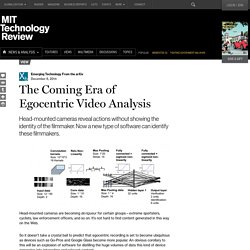
It’s not hard to find content generated in this way on the Web. So it doesn’t take a crystal ball to predict that egocentric recording is set to become ubiquitous as devices such as Go-Pros and Google Glass become more popular. An obvious corollary to this will be an explosion of software for distilling the huge volumes of data this kind of device generates into interesting and relevant content. Computer Vision and Pattern Recognition authors/titles recent submissions. Augmented Reality Startup Magic Leap, Funded by Google, is Working on Super-Real 3-D “Light Field” Display. A Florida startup called Magic Leap announced Tuesday that it had received $542 million in funding from major Silicon Valley investors led by Google to develop hardware for a new kind of augmented reality hardware.
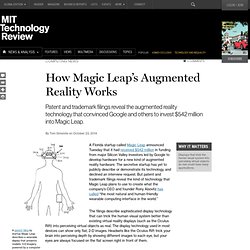
The secretive startup has yet to publicly describe or demonstrate its technology, and declined an interview request. But patent and trademark filings reveal the kind of technology that Magic Leap plans to use to create what the company’s CEO and founder Rony Abovitz has called “the most natural and human-friendly wearable computing interface in the world.” The filings describe sophisticated display technology that can trick the human visual system better than existing virtual reality displays (such as the Oculus Rift) into perceiving virtual objects as real. The display technology used in most devices can show only flat, 2-D images. When you look at a real 3-D scene, the depth at which your eyes are focused changes as you look at objects at different distances away. Random Image Experiment Reveals The Building Blocks of Human Imagination. Here’s a curious experiment.
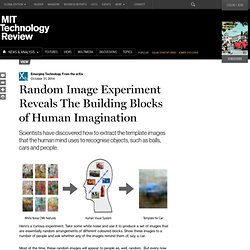
Take some white noise and use it to produce a set of images that are essentially random arrangements of different coloured blocks. Show these images to a number of people and ask whether any of the images remind them of, say, a car. Most of the time, these random images will appear to people as, well, random. But every now and again somebody will say that an image does remind them of a car. Set this image aside. Google's Secretive DeepMind Start-up Unveils A "Neural Turing Machine"
One of the great challenges of neuroscience is to understand the short-term working memory in the human brain.
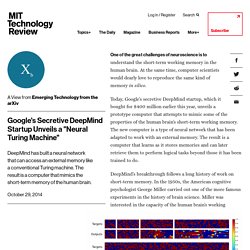
At the same time, computer scientists would dearly love to reproduce the same kind of memory in silico. Today, Google’s secretive DeepMind startup, which it bought for $400 million earlier this year, unveils a prototype computer that attempts to mimic some of the properties of the human brain’s short-term working memory. The new computer is a type of neural network that has been adapted to work with an external memory. The result is a computer that learns as it stores memories and can later retrieve them to perform logical tasks beyond those it has been trained to do.
DeepMind’s breakthrough follows a long history of work on short-term memory. Why Google Wants to Get Its Hands on Mystery Company 'Magic Leap' Gif: WIRED Source: Magic leap Magic Leap is the company everyone’s talking about and no one quite understands.
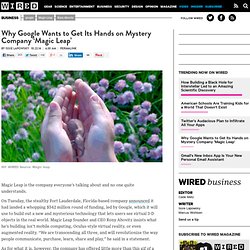
'Wearable Eyes' Make You Appear Friendly, Social Even When You're Not. Have you ever had trouble concentrating in the office as people walk by and glance at you?
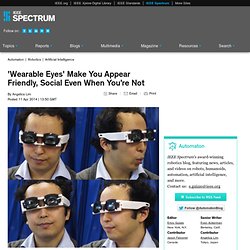
Do you come off as unfriendly or aloof, when you're really just focusing on your work?